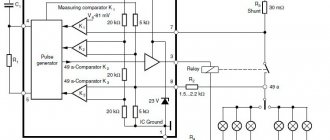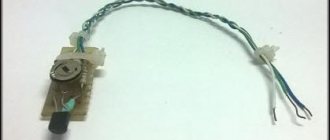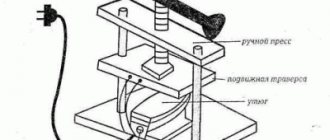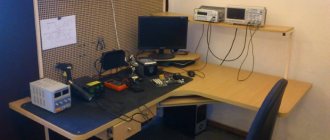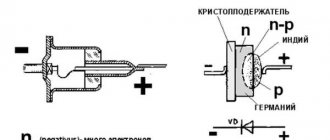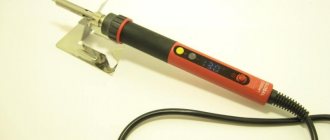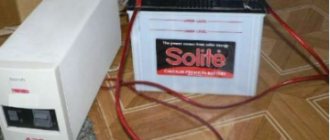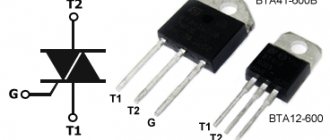Instructions for setting up the thermostat W1209
We customize the W1209 digital thermostat to suit your needs
After correctly connecting the W1209 thermostat (you can see it in this article), we move on to setting the temperature and other settings.
Depending on what we need to heat or cool (at a given temperature the relay will either close or open the contacts), we set one of two modes: cooling or heating. To do this, press and hold the “SET” button for more than two seconds, the display will show “P0”, this means that we have entered the program menu. The “+” and “-” buttons navigate through the program menu, but in our case we are at the desired value “P0”, so press the “SET” button again and select the desired mode: “C” is cooling, and “H” heat.
The next setting in menu “P1” is hysteresis, this is the temperature difference at which the thermostat turns on or off (factory setting 2°C). For example, the thermostat is set to turn off at +40°C; when this temperature is reached, the relay will open. And it will turn on only when the temperature drops to the set hysteresis, that is, at +38°C.
The next two menu items:
- “P2” is the upper limit for setting the maintained temperature (factory setting +110°C).
- “P3” is the lower limit for setting the maintained temperature (factory setting -55°C). When these temperatures are reached, the W1209 thermostat will be turned off.
Next in the menu is temperature correction “P4”, you can calibrate the temperature readings to one tenth of a degree (default 0°C).
Menu item “P5” is responsible for the relay activation time delay, which can be set to 10 minutes. (default setting 0 min).
The last item “P6” allows you to control overheating protection. OFF – protection is disabled, ON – protection is enabled.
Setting the temperature: press the “SET” button, the indicator will start blinking, use the “+” and “-” buttons to set the desired temperature.
To reset to factory settings you need to:
- turn off power
- press and hold the “+” and “-” buttons
- supply power to the thermostat
The LED display will show “888” and then display the current temperature.
How to set up the W1209 thermostat for an incubator. The setting of the thermostat.
From this article you will learn what the W1209 device is, how it works, and how to connect it.
W1209 is sold on the Chinese websites Ali-Express and Bangood. It is the cheapest of all the proposed analogues in this niche. The price of W1209 is only 143 rubles.
Shipped from China in 2-8 weeks. Free delivery. Items are shipped within 1 business day after payment is received. The product will only include a board, a bag, a chip and a sensor.
The thermostat is small. If you compare it to a matchbox, it will look even smaller.
The most noticeable detail of the product is the digital display, which shows the temperature down to one tenth of a degree. There are also three buttons and slots for connecting special wires.
W1209 is very easy to connect. Even an ordinary user who has no idea about electricity and the principles of its operation will be able to do this independently and without any effort. To connect an electronic thermometer, you need to find a special socket under the right screw, to the right of the display.
Video
To make a homemade incubator, I needed to purchase a temperature regulator. The requirements for it were: small dimensions, low cost, power supply from 12 V DC, a powerful executive relay (to withstand a significant load), indication of readings, setting parameters with control buttons, accuracy of temperature measurement and maintaining set parameters, and of course reliability.
On the Internet I came across such a device - . Reviews about it met my requirements. Came to me from the Aliexpress website. This regulator can be used in many places - electric heating, incubators, refrigerators, drying cabinets, water heating systems, protection of electrical equipment, measuring the temperature of a car's coolant and then turning on the fan in a greenhouse, bathhouses, heated floors, heating pipes, etc... The regulator itself consists of an electronic board with 3 control buttons installed: SET The SET button serves to select a mode and set parameters, and with the and buttons you can directly change the data of the programmable parameters. The LED indicator has three digits. The temperature meter itself is based on a thermometer installed in a case and has a wire length of 30 cm.
The control limits lie in the range from -50.0 to 110.0 degrees. You can connect loads up to 15 A (at 12 V DC) and up to 5 A (when powering the load from 220 V network)
The device is powered by 12 -14 V DC. The measurement accuracy is within 0.1 Celsius. The regulator current consumption is 35 mA when the relay is operating: 65 mA. In my article I will tell you how to set up and slightly upgrade this thermostat.
The process of setting up the W1209 thermostat is shown in the video:
List of tools and materials - knife or scissors; -screwdriver; - soldering iron; -tester; - a plastic tube from ear sticks or a pen refill; - faulty LEDs with a diameter of 5 mm - 4 pieces; - plastic stands - 4 pcs; - connecting wires; -12 V power adapter; -screws; -plastic box for screws with a transparent lid; -adhesive tape.
Step one.
Manufacturing of the body.
The disadvantage of the board is that it is not suitable for installation in the case; the buttons and indicator are located below the relay and terminals.
Step two.
Installation of the electronic thermostat board.
I installed the thermostat board on stands made of a plastic tube (from a ballpoint pen) as close as possible to the top cover. We make button pushers from plastic tubes from cotton swabs or from the refill of a ballpoint pen. Then at one end of the tube we increase the diameter with a warm soldering iron and put it on the buttons. The tube sat tightly as it was expanded into a cone by the soldering iron.
Step three.
Checking and adjusting the regulator.
I connected a 12 V adapter to power the thermostat (you can use any 12 V power source and a current of 0.1 A). I compared the temperature readings with a reference electronic thermometer, and as a result they turned out to be the same.
Setting modes.
P0 cooler or heater mode C/H P1 hysteresis setting 0.1-15 degrees (difference in relay switching mode) P2 setting the upper operating temperature limit P3 setting the lower operating temperature limit P4 temperature adjustment P5 relay switching delay (0-10 sec.) P6 emergency temperature rise. Mode P4 is used to adjust readings based on a reference device.
At this point all the finishing touches and alterations are completed. As a result, by mounting the board in a box, we protected the device from moisture and mechanical damage to the electronics and prevented people from being exposed to electric shock. After the modification, you can use the thermostat for its intended purpose.
In general, this is a good inexpensive device (100 rubles) with great potential in its field of application.
Operation of W1209 using the example of connecting to an incubator
The connection diagram for the thermostat here is almost the same as described above, only the following are added to the heating elements: a cooling fan, a 12-volt adapter, a fan, a heating element - incandescent light bulbs.
The figure below shows the diagram by which the incubator is connected. The wires of all electrical appliances are connected to the W1209 thermostat. Let's start with the arrival of alternating voltage.
On the right side you can see the block connecting the thermostat to a 220 volt DC network. However, it is not connected directly, but through a 12-volt adapter that converts 220 to 12 volts. This adapter connects to the two right slots - “minus” and “plus”.
In addition, a 12 volt fan is connected to the same wires. Incandescent lamps are connected to the two left slots
Please note that the light bulbs are connected directly to the network without transformers
The thermostat itself has a mode in which, if the normal temperature rises, the circuit opens automatically and the lights go out. The lamps themselves are connected in parallel so that more powerful incandescent light bulbs can be screwed in and they can also operate at only half their capacity.
The W1209 temperature sensor is not made in the best way, because the length of its wires does not exceed 50 centimeters. In most cases, this is not at all sufficient for the correct installation of the device in order to correctly measure temperature.
Since the display only shows us the current temperature value, the user will want to set the desired value for it. How to do it? As mentioned above, there are three more buttons on the thermostat: “set”, “plus” and “minus”.
Thanks to these buttons, you can set the required temperature parameters. This is done as follows - first you need to press the “set” button, then use the “minus” and “plus” buttons to set the required temperature at which the relay will turn on. Actually, the sensor will monitor these indicators.
If the temperature is below the set value, the contacts of the power terminals will close. The thermostat must be paired with a heater or cooler. If you hold down the “set” button for five or more seconds, the W1209 will go into settings mode. The following settings are available:
P0 - selection of heater or cooler P1 - hysteresis 0.1-15 °C, default 2 °C P2 - setting the upper operating temperature limit by default 110°C P3 - setting the lower operating temperature limit by default -50°C P4 - temperature correction - 7 +7°C, default 0 P5 - relay on/off delay 0-10 sec, default 0 P6 - alarm temperature over-temperature signal 0 +110 °C, disabled by default
Where P is a program, H is a heater (from English heat, hot) and C is a cooler (cool). Mode P1 is a hysteresis that keeps temperature fluctuations within certain limits. Set in settings.
Unfortunately, it is impossible to make all equipment work exclusively from a 12-volt adapter, because such voltage will not be enough to turn on incandescent lamps.
Another option for connecting the thermostat is the possibility of connecting it not to a constant voltage network (220 volts), but to a 12 volt power source, for example, it could be a car battery.
The figure below shows a diagram of connecting the battery to the thermostat. To the left of the w1209 is a heating element that operates at 12 volts.
Saturday, July 30, 2016
Chinese thermostat XH-W1209 instructions in Russian
Instructions for thermostat codes XH-W1209
Access to the thermostat programming codes is achieved by continuously pressing the Set button for 5 seconds. After this, P0 is displayed, then by searching + or - we select the parameter number.
The choice of parameter to change is carried out by the Set button, change + or -, writing to memory by the Set button.
P0—select heater or cooler. H - heating C - cooling. That is, if you need to turn on the heater when the temperature drops below the set one, select H; if, when the set temperature is exceeded, you need to turn on the cooler, select C P1 - hysteresis (0.1-15 °C, default 2 °C) 0.1. Hysteresis is the difference between the on and off temperatures. That is, if the operating temperature of the thermostat is set to 4 °C and hysteresis = 0.5 °C, heating mode H, then at a temperature of 4.5 °C the thermostat will turn off the heating, and at a temperature of 3.5 °C it will turn off. P2 - setting the upper operating temperature limit (default 110°C). This is simply the upper limit of temperature selection when setting in user mode. It needs to be set higher than the temperature to which the thermostat is set. For example, when setting the thermostat to an operating temperature of 4 °C, parameter P2 is set to, for example, 10 °C P3 - setting the lower operating temperature limit (default -50 °C). This is the lower limit of temperature selection when setting in user mode. It needs to be set below the temperature to which the thermostat is set. For example, when setting the thermostat to an operating temperature of 4 °C, parameter P3 is set, for example, 0 °C P4 - temperature correction (-7 +7 °C, default 0) 0.
The programmable thermostat is designed to control temperatures in the range from -50°C to +110°C. It can work in tandem with a heater or cooler. It is powered by a DC source of 12 volts. Current consumption is 60 mA. This device can control the temperature on the display and regulate it within specified limits. It can be used in an incubator, water heaters, thermal dryers, in a car and more in many places where it is necessary to maintain a constant temperature. We connect the load (lamps, heating elements, etc.) to the relay.
Setting up and operating the thermostat
The thermostat is configured using three buttons located under the display. These are the keys: “SET”, “+” and “–”. “SET” is responsible for selecting the control setting mode, plus and minus are responsible for increasing or decreasing the values of the adjustable parameters. In this case, one of two main operating modes is configured: either heating or cooling the temperature sensor.
When the temperature is within the limits programmed in the device menu, the relay is turned off; it turns on when it decreases or increases below the programmed hysteresis. At this moment, the relay turns on and remains in this state until the temperature changes to the level set in the device settings.
When operating in heating mode, the sensor reacts to a decrease in temperature. The microcontroller notes a decrease in temperature on the sensor below a certain parameter, opens the relay contact and applies a load to the alarm device. If it, in turn, is connected to a heating element, then the temperature at the sensor rises. When analyzing information from the sensor, the controller notes this parameter and its coincidence with the specified one. Then it turns off the alarm, reducing the load. The same process, but in reverse order, is used in cooling mode.
The controller receives information from the sensor; the connector for it is located on the main board of the device. The temperature sensor itself, with a sealed waterproof NTC 10K housing with a resistance of 10 kOhm, is connected by wire through a connector on the board. The only drawback is the short length of the cable - only 30 cm, but if necessary, the wire can be replaced with a longer one. The device diagram is shown below.
Important! The parameter settings are saved even when you briefly press the SET key, so you need to be extremely careful when working with the thermal relay control
Electronic thermostat W1209
The temperature setting and display range is -50ºС +110ºС, which is quite enough for domestic use. The red LED 3-digit indicator 22×10mm shows temperature up to tenths of a degree, temperatures below -10ºС (up to -50ºС) and above 100ºС (up to 110ºС) displays without decimals, because There are not enough indicator digits. The discrete setting is set according to the same principle. The red LED on the board simply duplicates the switching on of the relay.
3 control buttons: set, +, - .set - selects the setpoint mode and parameter settings + and - changes the value of the setpoint and parameters It was more logical to place the + button on the right, and not in the center, because
Calibration of thermal relay W1209
DIY thermostat
Thermal relay calibration is carried out in programming mode in menu item P4. For calibration you need to have a reference thermometer. Comparing the readings of the standard with the readings of the design, they are brought to the same values by manipulating the “+” or “-” buttons. After exiting the settings, W1209 automatically adjusts the measurement temperature over the entire range.
If you don’t have a thermometer, you can use the known values:
- Snow melting temperature – 0°C;
- The boiling point of water is 100°C.
For domestic use, the error will be within acceptable limits when calibrated using boiled water instead of distilled water.
P O P U L A R N O E:
Types of gas boilers
The industry produces single-circuit and double-circuit gas boilers. Single-circuit - provide only heating. In addition to heating, double-circuit boilers also provide hot water supply to the house. Double-circuit boilers are also divided into boilers with a boiler and boilers with a flowing supply of warm water.
Do-it-yourself equipment repair
Sooner or later, the TV, receiver, modem, etc. stops working. Most of the failure rate of radio equipment occurs due to drying out of electrolytic capacitors.
Because of this, the device begins to turn on for a long time or does not turn on at all, changes in operation, freezes and failures occur.
Even a novice radio amateur can fix such a malfunction easily and quickly.
It is best to use a ready-made refrigerator housing for the incubator. It is both warm and roomy. Here we describe the manufacture of an incubator from the body of a household refrigerator such as “Polyus”, “Oka”, etc. Read more…
Thermostat for heating element and connection of heating element with thermostat
This is good at low temperatures outside. Control method It can be of two types: Mechanical, when the physical characteristics of the opening contacts change.
Plugging in. For electric boilers, such thermostats are a mandatory addition. Depending on the installation location - directly on the unit or in the actual area of the room, remote devices, the thermostat responds to changes in the temperature of the heater body or air in the room and turns the heater on and off, maintaining the preset mode.
At the same time, it is imperative to control the area in which the heating equipment is located and not leave it unattended.
The design of controlled temperature controllers can be of two types: capillary - a special relay in the form of a narrow cylinder, in which there is a cylindrical capsule with a liquid having a high coefficient of thermal expansion - the capsule closes and opens contacts with changes in temperature using a special design drive; used in liquid-filled radiators; bimetallic plate - an element combined from two dissimilar metals with a significant difference in the coefficients of thermal expansion - when heated, the halves of the plate elongate so much that they bend in the landing socket and open the electrical circuit, and after cooling they return to their dimensions and close the contacts. In both cases, control is carried out manually, by setting the required temperature on the controller body. Group 3: electronic This type of thermostats for hot water boilers belongs to the volatile category.
The lever mechanism of the thermostat, which is located in the box, acts on the contact group when cooling - the thermostat opens. This option is the most expensive of all presented. The range is adjusted by resistor R3.
The best option would be to purchase the same device that has become unusable. When implemented, many of the most important disadvantages of previous methods are eliminated. Having assembled the adjustment-switching unit, you must first check the correct installation, and only after that begin setting up the entire system.
Let's take a closer look at temperature-regulating devices, standard and remote, installed on infrared heaters
When choosing devices in this category, you need to pay attention to the following points: Case material. The maximum current that the new thermostat will need to handle
For example, using an externally similar temperature sensor K.5 instead of K.5 will lead to freezing in the rear wall of the refrigerator and a change in the temperature regime of the refrigerator. In addition to standard regulators, which are mandatory for installation and optimize heater control, controllers are produced for additional equipment of heaters in order to increase their efficiency and functionality.
Switching on a three-wire circuit is used when heaters or any other load are designed for operating voltage V. The load of this microcircuit is a PC fan. The regulating device, whose power is usually 3 kW, has 4 terminals - two for connection to the circuit breaker on the electrical panel, and two to the heating unit. Along with the amount of steam, the pressure inside the tank also increases. An externally located thermostat has a thicker body, which is covered on all sides with plastic plates. Connecting a Chinese thermostat
Review of thermostats from AliExpress for 220V
Thermostats with Wi-Fi and the ability to monitor via the Internet are certainly good.
But now let's look at the cheapest digital thermostats.
A feature of thermostats in the price group up to 500 rubles is the impossibility of installing them without additional funds.
There are no terminals and just wires coming out that are soldered to the board. Or there is no case at all. Or there is a housing and terminals, but there is no way to hide the wires.
If you wish, of course, you can suffer and lead the wires inside a small case, making the connection inside.
Therefore, you either need to use a mounting box for devices on a DIN rail, since the size is suitable, or run the wires in a cable channel.
Unless the thermostat is hanging in the coop.
Only models that operate with a voltage of 220V are considered, although each product item has the ability to select an operating voltage of 12/24/220V. Thermostats powered by 12/24V are probably more accurate and reliable, but how do you control them? The price is for 220V.
Almost all models do not have dry relay contacts, but switch 220V voltage to the output. The neutral wire of the output is connected to the input, and the ground is switched.
But they also occur with dry contacts, and you need to check what version the device came with.
If you connect a thermostat, assuming that it has dry contacts, a short circuit may result if the thermostat switches phases and forwards zero.
According to the logic of operation, temperature control can be of two types:
1. Set the switch-on temperature (P0) and switch-off temperature (P1).
2. Set the maintenance temperature and (hysteresis).
Some thermostats have temperature correction.
| Model Price | Appearance | Link with original title | Peculiarities |
| W3001 200r | W3001 Digital Control Temperature Microcomputer Thermostat Switch Thermometer New | ||
| W3002 220r | 220V Professional W3002 Digital LED Temperature Controller 10A Thermostat Regulator XH-W3002 | ||
| W1088 600r | Dual Digital Thermostat Temperature Controller Two Relay Output Thermoregulator for incubator Heating Cooling XK-W1088 12V 220V | ||
| W1209 543r | DTC1200 Intelligent Temperature Controller AC110V 220V LED Digital Thermostat Thermometer Temperature Sensor Cooling Heating | ||
| DMT01 600rub | DMT01 110V 220V 12V 24V LED Digital Temperature Controller Regulator Thermostat Thermoregulator Heating Cooling Control | ||
| ST3012 520r | DC 12V 24V AC 110-220V ST3012 LED Digital Dual Thermometer Temperature Controller Thermostat Incubator Microcomputer Dual Probe | ||
| W88 300r | W88 110V 220V Digital Thermostat Temperature Controller Thermoregulator for incubator Relay 10A Heating Cooling Control | ||
| W1411 300r | XH-1411 W1411 Display Digital Temperature Controller Multi-function Thermostat Thermometer Control Switch DC 12V AC 110V-220V | ||
| KT3003 300rub | AliExpress.com Product – KT3003 W3230 Mini Temperature Controller -55~120C Heating/Cooling Thermostat Regulator 10A/220V/20A 12V 24V Thermoregulator | ||
| W3230 300r | W3230 AC 110V-220V DC12V 24V Digital Thermostat Temperature Controller Regulator Heating Cooling Control Instruments LED Display | ||
| W3230 300r | W3230 DC 12V 24V 110V 220V AC LED Digital Temperature Controller Thermostat Heating Cooling Control Switch Instrument NTC Sensor | ||
| EP00495 241r | EP00495 | ||
| KT88 490rub | KETOTEK KT88 Temperature Controller Thermostat Digital Thermostat Regulator Temperature Control for incubator 10A 220V 12V 24v | ||
| KT99 490rub | 12V 24V 220V 10A KT99 Digital Thermostat Incubator Temperature Controller Thermoregulator Heater Cooler Control With Dual Probe | ||
| SN093 920r | SN093 | ||
| ZL-6290A 800rub | ZL-6290A, Celsius Fahrenheit, option, Similar to STC-1000, ITC-1000; Dual 10A outputs, Thermostat, STC 1000 | ||
| STC-1000 620r | LED Digital Temperature Controller STC-1000 12V 12V 24V 220V Thermostat Thermostat and Heater Cooler Control | ||
| MK-605 690rub | Free Shipping 220V 16A LCD Programmable Floor Heating Room Thermostat Temperature Room Controller Thermo Regulator | In a full-fledged building. Doesn't fit into standard socket box. Price for 3A device. 737 orders. |
More posts on the topic
Which Wi-Fi thermostat should I buy on AliExpress?
Non-room WIFi thermostats
Comparison table of Wi-Fi thermostats with cloud service
Room thermostats from Aliexpress 2020
We replenish the fleet of chargers with Olaf gadgets from AliExpress
Review of thermostat models with WiFi and cloud service.
Do-it-yourself modernization of the W1209 thermostat module
The design of the device provides ample opportunities for modernization. You can modify the device as follows:
- Place the thermal relay in the housing;
- Extend the temperature sensor cable;
- Change the firmware version.
The last point can be accomplished if you have skills in working with programmable controllers. For this purpose, use the ST-Link V2 USB programmer. The required firmware version can be downloaded from the official website of the controller manufacturer. Redesigning the device by changing the firmware to a newer one allows you to introduce new functions and improve performance characteristics.
Housing option
Modifying the cable makes sense due to the short length of the standard sensor wire (about 0.5 m).
Modification of thermostat W1209
Due to the compactness of the main board of the thermostat, the RESET input, the fourth terminal of the controller, is connected to contacts for programming. This leads to the occasional spark throwing off the controller's set values. This drawback is eliminated by installing a 0.1 µF SMD capacitor on a common cable.
Despite the relatively low price, the XH-W1209 thermostat is an effective and compact device for automatic control of temperature conditions. Due to its technical and operational characteristics, it can be used both for various types of technical devices, and directly for temperature control in mini-saunas and baths.
Do-it-yourself modernization of the W1209 thermostat module
The design of the device provides ample opportunities for modernization. You can modify the device as follows:
- Place the thermal relay in the housing;
- Extend the temperature sensor cable;
- Change the firmware version.
The last point can be accomplished if you have skills in working with programmable controllers. For this purpose, use the ST-Link V2 USB programmer. The required firmware version can be downloaded from the official website of the controller manufacturer. Redesigning the device by changing the firmware to a newer one allows you to introduce new functions and improve performance characteristics.
Housing option
Modifying the cable makes sense due to the short length of the standard sensor wire (about 0.5 m).
Electronic thermostat W1209 | arduinoLab
A simple and cheap Chinese module on which you can implement heating or cooling control.
Module features:
The thermostat is assembled on an STM8S003F3P6 microcontroller, a thermistor in a sealed flask is used as a temperature sensor, a 3-digit 7-segment indicator is used to display temperature and other information, parameter settings are set using three buttons, the load is controlled using the SRA-12VDC-AL relay, has LED indicating relay activation.
Characteristics:
- Temperature control range: -50°C … +120 °C
- Temperature control accuracy: 0.1°C
- Hysteresis: 0.1 … 30 °C
- Supply voltage: 12VDC
- Sensor: Sealed NTC 10K 0.5%
- Cable length 0.3m
- Maximum load current: 5A/220VAC; 15A/14VDC
Instruction sheet
The module has only 4 terminals, two K0, K1 relay contacts, +12V and GND power supply of 12 volts, respectively.
Setting the temperature and setting up the module:
To set the thermostat temperature, you need to briefly press the “SET” button, the module will go into settings mode and you can use the “+” and “-” buttons to set the temperature, after 5 seconds of inactivity the module will return to normal mode.
To get to the module settings menu, you need to hold the “SET” button for more than 5 seconds, after which the menu will be displayed on the screen.
| Code | Parameter | Range | Default |
| P0 | Operating mode: Heating\Cooling | H\C | WITH |
| P1 | Hysteresis | 0.1 – 30 °C | 2.0 °C |
| P2 | Maximum temperature | +120 °C | |
| P3 | Minimum temperature | -55 °C | |
| P4 | Temperature adjustment | +10 … -10 °C | 0 °C |
| P5 | Relay activation time delay | 0 … 10 min. | |
| P6 | Overheating protection (if there was a buzzer on the module, it would make a DiDiDi sound if the temperature went beyond the settings in P2, P3) | -55 °C … 120 °C | OFF |
| P7 | Locking settings (protection from those who like to press buttons) | OFF | |
| P8 | Reset | OFF |
Overview of the W1209 digital thermostat module
The W1209 digital thermostat module from China is popular due to its versatility and attractive price.
It can be used both for an incubator (in “heating” mode) and for a fan (in “cooling” mode).
It can also be used to control and maintain the engine temperature in a car or car interior by connecting an electric fan to its contacts. It is suitable for cooling a computer system unit or, for example, attached to a freezer, water tanks, a steamer, industrial equipment, heated floors, baseboards or ceilings and many other heating or cooling systems with adjustable temperature.
You can also inexpensively buy a dismountable transparent case for the module.
It is worth noting that to work with the module you do not need to use an additional thermometer - it displays the real temperature value in the sensor area. A waterproof temperature sensor (NTC 10K 0.5%) is supplied with the module.
W1209 MODULE DIAGRAM
For proper and long-term operation of the thermostat, it is necessary to supply a stabilized power supply of +12 volts. The module remains operational when the power supply drops to 10V. A 5V stabilizer is installed on its board (m/s AMS1117).
There is a relay on the module board that switches loads with voltages up to 220V and current up to 10A.
W1209 Specifications:
- Temperature control range: - 50 … + 110 ° C
- Resolution: 9.9 to 99.9; 0.1 ° C; 1°C
- Measurement accuracy: 0.1°C
- Control accuracy: 0.1°C
- Accuracy (Hysteresis): from 0.1 to 30° C
- Temperature update rate: 0.5 sec.
- Power: + 12 V (stabilized!)
- Measuring inputs: NTC (10K 0.5%)
- Output: relay contacts 14V to 20A, 125V to 20A, 220V to 10A.
Operational requirements:
- Ambient temperature: -10 … + 60 ℃
- Humidity 20%...85%
- Power consumption:
- Current: 22mA (with relay off)… 72mA (with relay on)
- Size: 48 (L) x 40 (W) x 14 (H) mm
- Total weight: 20g
Temperature setting
Briefly press the “SET” button and then use the “+” and “-” buttons to set the value of the maintained temperature. Press “set” again and the thermostat will remember the value and go into the mode of maintaining the set temperature.
Programming mode
To enter the programming menu, press and hold the “SET” button (about 5 seconds). You will enter the main settings menu. To switch modes P0…P8, press + or -. To change modes P0 ... P8, press the “SET” button, then + or -. Long press SET (about 5 seconds) or within 10 seconds if no button is pressed, the menu will be memorized and exited.
Setup menu (default values in brackets)
Modules are available with two firmware versions:
Menu for new firmware
- P0 - Cooling / Heating - C / H (C)
- P1 - hysteresis settings - 0.1 - 30 (2)
- P2 - setting the upper limit +110 ° C (110)
- P3 - setting the lower limit - 50 ° C (-50)
- P4 - Temperature error correction -7 ... +7 ° C (0)
- P5 - Start time delay - 0 ... 600 sec (0)
- P6 - Alarm (this function is not used)
- P7 — Upper alarm temperature threshold — 0…110° C (OFF) (forced switching off of the relay, dashes light up on the screen —)
- P8 - Reset to factory settings - S/N (when switching the parameter, all settings are reset)
Menu for old firmware
- P0 - Cooling / Heating - C / H (C)
- P1 - hysteresis settings - 0.1 - 15 (2)
- P2 - setting the upper limit +110 ° C (110)
- P3 - setting the lower limit - 50 ° C (-50)
- P4 - Temperature error correction -7 ... +7 ℃ (0)
- P5 - Start time delay - 0 ... 10 Minutes (0)
- P6 - Upper alarm temperature threshold - 0 ... 110 ℃ (OFF) (forced switching off of the relay, dashes light up on the screen -)
Module faults
If the display shows: LLL - break in the temperature sensor;
N N N or 110 - short circuit of the temperature sensor;
888 — on the display with new firmware it means a sensor malfunction (break or short circuit).
Reboot. If the module is frozen, the display does not light up or the module behaves inappropriately, and power is supplied to the module (DC 12 V), you need to restart the module and return all settings to the factory values. To do this, turn off the power to the module, press the “+” and “-” buttons simultaneously and then supply power to the module.
Refinement of the module
On the board, the RESET input (4 pin of the controller) is connected to programming contacts and the controller is sometimes falsely reset due to strong spark noise from the relay or power supply. The modernization consists of installing a capacitor with a capacity of 0.1 µF on the common wire (-).
Flashing the W1209 module
Sometimes the module starts acting strange, glitching, etc. To flash the module we need:
- USB programmer ST-Link V2. The cost of such a programmer on Aliexpress is about 200 rubles.
- Software for the programmer on the offsite: https://www.st.com/web/catalog/tools/FM147/CL1794/SC1807/SS1747/PF210568 (driver and programming software). Below is the link. (To download, you need to fill out the table and a link will be sent by email).
- Comb with a pitch of 2.54 mm for programming (you can do without it, we use wiring for this).
Step 1. Connect the programmer to the programming connector on the W1209 board. The programmer is signed:
- GND
- RESET
- SWIM
- +5V
Step 2. Launch the ST-Link Visual Programmer , set the programming parameters:
Step 3. Do not apply +12V to the board! Powered by ST-Link . Connect the programmer to USB.
Step 4. Try to read the data. If an error occurs, the chip is read/write protected. You need to unlock: the options tab, the first is the program, the second is eeprom, the third is the option bytes (we need the third one at the bottom), switch to it and make a write page.
Attention! Now the old firmware is Erased!
Try to subtract - if everything is fine, the chip will start reading as zeros.
Step 5. Now we write the new firmware. File - open - select old_termo.hex, unpacked from the archive (taken from user comments). Click - Program - All Tabs.
Recommendation
For reliable long-term operation of the thermostat with a load of more than 300 W, it is better to use a powerful intermediate relay or triac.
Option to install the module in a machine box.
Finished look. To program, you need to open the lid.
You can buy the module in stores from China. Delivery about 1-3 months. You can buy a verified module on the Trowel website, delivery is about a week.
Setting procedure
Settings are carried out using control keys. So, when you press the “SET” button simultaneously, the indicator starts blinking, and the current module settings are displayed on the display. At this point you can change the values using the plus and minus keys. If there is no action on the control buttons, the sensor returns to operating mode; it should be noted that the changes made before turning off the menu are saved in the memory of the W1209 relay chip.
A long press on “SET” will launch the programming mode and set parameters. The instructions offer a detailed description of all operating modes of the device, as well as the main values for which the device is designed, but we will duplicate the information here. In this case, the parameter menu appears on the display:
- P0 – main thermal relay modes: heating or cooling, letters C and H, cooling is set by default;
- P1 – hysterisis change: from 0.1 to 15, default 2;
- P2 – maximum positive temperature, default 110 ºС;
- P3 – maximum negative temperature, -50 ºС;
- P4 – correction: -7.0 and 7.0ºС, precise calibration of the temperature range;
- P5 – time delay for turning on and off the thermostat, up to 10 minutes, default 0;
- P6 – limit shutdown temperature, protection against device overheating, disabled by default – OFF.
All information is stored in the board controller, and the settings are saved even if the thermostat is briefly disconnected from the power source.
Resetting to factory settings is carried out by simultaneously pressing the SET, plus and minus keys for some time.
Child lock
The last thing I would like to note is the blocking from “moving children”. If you have configured the thermostat as needed, you can “lock” it, just press the “up” and “down” keys simultaneously for five seconds, a lock icon will appear (unlock in the same way).
Guys, that's all. These are the basic settings, sorry if it’s not very clear. For this, I also created a video version, I simply “chewed” the information there, so let’s take a look.
How to bring to life the multifunctional thermostat W1209 in an hour
The process of setting up the W1209 thermostat is shown in the video:
List of tools and materials - knife or scissors; -screwdriver; - soldering iron; -tester; - a plastic tube from ear sticks or a pen refill; - faulty LEDs with a diameter of 5 mm - 4 pieces; - plastic stands - 4 pcs; - connecting wires; -12 V power adapter; -screws; -plastic box for screws with a transparent lid; -adhesive tape.
Step one.
Manufacturing of the body.
The disadvantage of the board is that it is not suitable for installation in the case; the buttons and indicator are located below the relay and terminals.
Craftsmen arrange the board of this regulator in different ways - some cut out windows in the case for indicators, relays, connectors, some solder the buttons and indicator, then mount them separately. But I decided to install the board in a transparent case, a box of screws fit. At first I wanted to paint it after sealing the window for the LED indicator screen. But then I changed my mind and decided to cover it with self-adhesive film (there were pieces left over from the repair). It came out quickly and in my opinion seems good. Then we make a window in the film for the LED indicator screen and drill passages for the buttons
Step two.
Installation of the electronic thermostat board.
I installed the thermostat board on stands made of a plastic tube (from a ballpoint pen) as close as possible to the top cover. We make button pushers from plastic tubes from cotton swabs or from the refill of a ballpoint pen. Then at one end of the tube we increase the diameter with a warm soldering iron and put it on the buttons. The tube sat tightly as it was expanded into a cone by the soldering iron.
After we close the top cover and insert the faulty LEDs onto the protruding pushers, having first bitten off part of the legs - they will become the buttons themselves. The board has an LED to monitor the operation of the relay. It was hard to see from under the cover; I glued the transparent part of the burnt-out LED onto it, and it became much brighter.
Step three.
Checking and adjusting the regulator.
I connected a 12 V adapter to power the thermostat (you can use any 12 V power source and a current of 0.1 A). I compared the temperature readings with a reference electronic thermometer, and as a result they turned out to be the same.
Setting up the regulator is easy. To enter the programming mode, you need to press and hold the SET button for 6 seconds, then adjust using the buttons. To save the setting, press and hold the SET button, or do not touch the buttons for 10 seconds. All thermostat settings will remain in the controller’s non-volatile memory even after the device’s power is turned off.
Setting modes.
P0 cooler or heater mode C/H P1 hysteresis setting 0.1-15 degrees (difference in relay switching mode) P2 setting the upper operating temperature limit P3 setting the lower operating temperature limit P4 temperature adjustment P5 relay switching delay (0-10 sec.) P6 emergency temperature rise. Mode P4 is used to adjust readings based on a reference device.
At this point all the finishing touches and alterations are completed. As a result, by mounting the board in a box, we protected the device from moisture and mechanical damage to the electronics and prevented people from being exposed to electric shock. After the modification, you can use the thermostat for its intended purpose.
In general, this is a good inexpensive device (100 rubles) with great potential in its field of application.
We modify the W1209 thermostat and make a housing for it
Daco Loading
18.04.2019
4419
Follow the author if you like his publications. Then you will receive notifications about his new posts.
You can always unsubscribe from notifications in the author's profile.
Subscribe
31
Greetings everyone.
Many people are familiar with the W1209 thermostat. Inexpensive, proven, almost ideal for various homemade products. But I personally don’t like the fact that the relay and terminal block, plus the sensor connector are on the front side and protrude above the buttons and display. Anyone who tried to implement this device into the body of something will understand me. But there is a very simple solution to this “problem”. In addition to this, exactly a week ago I became the proud owner of a 3D printer and I simply could not help but model the case for the modified w1209; there are a lot of such boxes for original thermostats, but I have never seen such boxes for the “reversal”. In general, in order.
Let's modify it.
Our thermostat looks like this before the operation.
Since a conventional electromagnetic relay switches the load in this thermostat, and the sensor is a thermal resistance whose polarity is not important, we can simply transfer all this stuff along with the terminals to the reverse side. This will increase the dimensions of the module by 6 mm in height, but will save us from the components that interfere with the front side, which need to be desoldered at the first stage.
Next, we try on the relay on the back side and under the contact, which has now changed its position relative to the previous holes, put a mark and drill a new hole (highlighted in red in the photo), clean the area around the hole from the solder mask, tin, install the relay in a new place and solder. We also solder the block with terminals and the sensor connector on the reverse side. The changeling is ready!
Now it looks like this.
The purpose of creating this box is to have a mobile thermostat so that, depending on the task, it can be connected to different devices. A dryer for vegetables, for example, or a brooder for poultry, etc. The body was developed in Fusion 360. There are no small screws for plastic at home and there is no desire to go to the city because of them, I decided to fasten the halves of the body to each other with latches. To install the thermostat vertically, I made cutouts in the case and a bracket that fits into these cutouts and holds the device in a vertical position. The bracket itself can be attached with a self-tapping screw or double-sided tape. The bracket is provided for mobility and ease of maintenance, screw it to the wall, connect the wires, install the thermostat, that's it.
Printing
While I didn’t have any difficulties with modeling, I’m still figuring out the printing settings. The result is in the photo.
I printed PLA+ from eSun, Ender3 printer, table 60°C, nozzle with a diameter of 0.4, temperature 210°C, layer thickness 0.1, 100% filling (the models are not large, the savings in time and plastic are negligible compared to filling in 30%), speed 60.
Body parts without supports, bracket with supports. To be honest, I don’t know what else to write, I’m new to this business, maybe the settings are not correct at all. Who is interested in Fusion 360 files here.
Let's sum it up
Creating a model on the screen and holding it in your hands are, of course, different things. It seems like nonsense compared to talking speakers or unmanned equipment, for example, I spent time, spent money, it would have worked without all this, but the joy is like that of a child. I will be even happier if the above is useful to someone.
Thank you for reading. All the best.
Follow the author if you like his publications. Then you will receive notifications about his new posts.
You can always unsubscribe from notifications in the author's profile.
Subscribe
31
Source: https://3dtoday.ru/blogs/daco/modify-w1209-thermostat-and-make-for-it-body-/
Connection diagram W1209
W1209 operates on direct current - 12 volts. Below is a diagram for connecting W1209. There are four slots on the central block. The left two slots are for connecting heating elements, the right two are for connecting energy.
According to the diagram, the thermostat can be powered from a 220 volt network. However, the next element in this circuit must be a special transformer that can convert 220 volts to 12 volts DC voltage.
To the left of the gray block is a heating element (with two hieroglyphs), which can be connected directly to the W1209. The contact in the thermostat opens and the heater turns off.
Bottom line
The W1209 thermostat is an excellent product for using temperature control in a homemade device such as an incubator. It perfectly maintains the optimal temperature.
If it fails during a sudden power surge, it can be replaced with an analogue one. In addition, it costs 140-150 rubles. W1209 is very easy to use, even the most novice user without special knowledge of the operating principles of an electrical circuit will be able to connect it and use it effectively.
Thermostat W1209 - video on how to use this device
The W1209 thermal relay module is designed to control temperatures in the range from -50 to +100 degrees. Equipped with a 3-character LED display, a relay activation indicator, three electronic thermostat control buttons, a connector for connecting an external temperature sensor, “K0/K1” terminals for connecting a load and “+12V/GND” for powering the thermostat board. The display shows the current measured temperature from the sensor, “LL” if the sensor is not connected, and “HH” if the temperature is out of range.
Characteristics of thermal relay W1209:
| Thermistor | NTC (10K 0.5%) waterproof sensor |
| Temperature Range | -50°C to +110°C |
| Measurement accuracy | |
| Control precision | 0.1°C between -9.9°C and 99.9°C, or 1.0°C outside this range |
| Update time | 0.5 seconds |
| Hysteresis (lag) | 0.1°C……. 5°C |
| Hysteresis accuracy (lag) | 0.1°C |
| Supply voltage | DC 12V |
| Quiescent current | |
| Operating current | |
| Output voltage | DC 12V |
| Maximum load current | 5A/AC 125V, 15A/DC 14V |
| Permissible humidity | from 20% to 85%, Rh |
| Length of cable | 0.3 meters |
| Dimensions | 48mm*40mm |
Preparing for work:
- Connect a 12V DC power supply to the “+12V” (plus 12V) and “GND” (minus 12V) contacts.
- Connect the load to contacts “K0” and “K1” (connected to the open power circuit of the controlled device - serial connection)
After supplying 12V power to the “+12V” and “GND” contacts, the LED display will display the current temperature measured by an external temperature sensor
Setting and setting the set temperature:
To set the control temperature, briefly press the “SET” button. then use the “+” and “-” buttons to set the desired temperature. After setting the temperature, you must press the “SET” button again, or do not press any buttons for 5 seconds.
Programming:
- To enter the programming mode, press the “SET” button for 5 seconds!
- Use the “+” and “-” buttons to select the menu parameter code (P0….P6) from the table “Thermostat Menu”
- To configure a parameter, press the “SET” button and use the “+” and “-” buttons to change the parameter value
- To save the settings, press the “SET” button, or do not press any buttons for 5 seconds.
To reset settings to factory settings (default settings):
- Turn off the power
- Press and hold the "+" and "-" buttons
- Apply power to the thermostat
The LED display will show “888” and then display the current temperature.
The W1209 thermostat is an electronic device whose main task is to control the temperature and maintain it at certain values. Similar relays are used in devices to maintain a constant temperature: incubators, heated floors, greenhouses and greenhouses.
The w1209 programmable thermostat has such an important quality as low cost; it is currently the cheapest device on the market. The price of this device is in the range of 150-300 rubles.
Tags: automatic, sconce, throw, top, view, choice, hysteresis, house, , cable, like, oscillation, capacitor, , installation, power, load, voltage, setting, heating, soldering iron, connection, principle, wire, start , , work, size, regulator, resistor, relay, repair, row, garden, light, LED, resistance, circuit, ten, type, current, transformer, installation, panel, electrical panel, effect
Module overview
Thermostat W1209 is a programmable temperature control relay. The supplied sensor is operational in the temperature range from -50°C to +110°C. The regulator is designed to work with heating and cooling equipment with a power of up to 1 kVA.
Thermostat W1209
Technical characteristics of the w1209 thermostat:
- Controlled temperature range – -50°C – +110°C;
- Measurement accuracy in the range from 9.9°С to 99.9°С – 0.1°С, above the range – 1°С;
- Control accuracy in the range from 9.9°С to 99.9°С – 0.1°С, above the range – 1°С;
- Hysteresis setting – from 0.1°C to 30°C;
- Control current (load) = 14V – 20A, ≈220V – 10A;
- Supply voltage – 12V;
- Current consumption – 22-72 mA;
- Overall dimensions – 48x40x14 mm;
- Weight – 20 g;
- Permissible operating temperature – -10°C – +60°C.
Note! Some sellers position this device with the name xh w1209. All devices of this type are absolutely identical.
